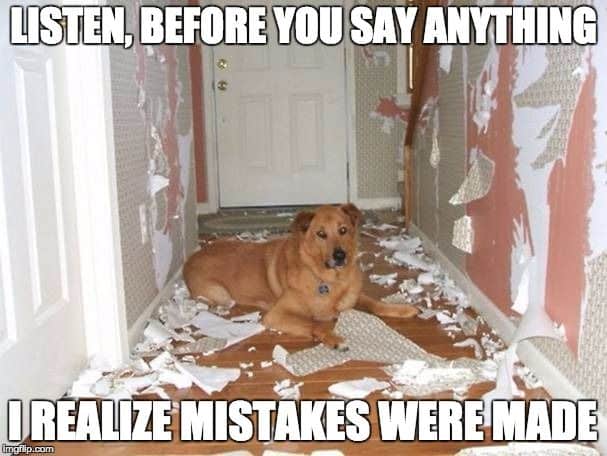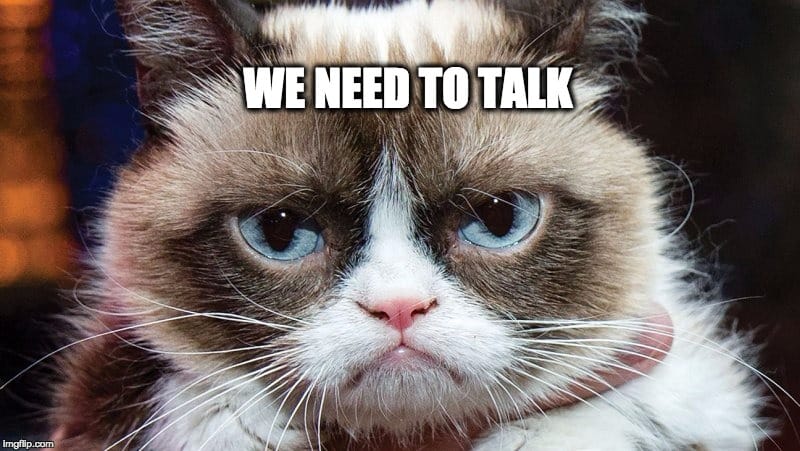Happy Clients and Happy People: Dealing with Problems the Right Way
by Casey Walrath • August 4, 2015
I’d like you to raise your hand if you’ve haven’t ever had to deal with a situation where someone you worked with—a client, a vendor, a customer—was unhappy.
If your hand is up, please leave a comment telling me about this magical job of yours. For the rest of us, you know that dealing with an unhappy person, or being that unhappy person, can be difficult and stressful.
I’m no expert in conflict resolution, but I’ve been working in pay per click management for Disruptive Advertising long enough that I’ve had to put out a few fires, some of my own making. Before that I worked in tech support, which is nothing but putting out fires!
So, I wanted to share a few tips based on what I’ve learned.
Here’s the best solution I’ve found for good conflict resolution: never mess up. If you can do that, you’re at least halfway there. Just surround yourself and work with people who never mess up either and you’re all set!
Avoid Problems with Good Communication and Time Management
Of course, there are still plenty of things you can do to minimize problems in the first place, a lot of which has to do with staying organized and maintaining good communication. I wrote a whole blog post that covers exactly how to use your time more intelligently!
The gist is, make sure you and the people around you understand what you’re doing and what’s expected of everybody. In PPC management I’ve found that nothing annoys clients more than not knowing what the strategy is for their PPC accounts, so providing regular updates on that is the best way to avoid problem.
Similarly when working with vendors (or employees/coworkers!), it’s important to let them know what your expectations are. A good vendor will be sure to ask semi-regularly, but sometimes you’ll have to drive that conversation.
But what do you do when the process breaks down?
Resolving Problems Right
For starters, if you’re the one who messed up—again, raise your hand if you haven’t, because I’d like to learn from you—there are a few things you can do to set things right. Let’s go through a scenario where a client notices a mistake before you do. Let’s say it’s something relevant to my industry: a misspelled headline on a landing page.
1. Validate the concerns
In a scenario like this, it’s always better if I’m the one who discovers the mistake, fixes it, and reports it to the client. But if they call me, having noticed a spelling error on their site, then chances are they’re going to be a little unhappy.
And that’s okay! The absolute worst thing is to get defensive, even if the problem is something relatively minor. People get emotional, but escalating can only make it worse. Instead, it’s best to take a deep breath and say something like, “I just pulled up that page and I can see the misspelling right here. I totally get how that’s a problem. That’s not representing your business in a good way, I understand.” A little empathy goes a long way.
Remember that with many mistakes, the real issue isn’t the mistake itself, but the lack of trust that it can create, especially for newer business relationships. If there was a mistake here, the client might wonder, what other mistakes might be out there?
It’s your responsibility to understand where they’re coming from and reestablish that trust, which brings us to the next point.
2. If it’s your fault, take responsibility
Let’s imagine that the misspelling isn’t even my fault. Maybe I’d delegated the copywriting to a coworker or a designer. It’d be easy to place the blame on them. Or, more commonly, to deflect blame with vague language like, “Okay, we seem to have made a mistake somewhere…”
But that’s a terrible way to communicate!
If I’m the Account Strategist, the ultimate responsibility lies with me, period. That means I should be telling the client, “You’re right, this one is my fault, and I apologize.” Take ownership of the problem.
But don’t over apologize. When people get emotional we all tend to repeat ourselves, so someone who’s upset might bring up a problem more than once. Again, that’s okay! It’s my job to continue empathizing and validating, but repeatedly apologizing isn’t going to accomplish anything. Instead, it’s best to show what you’re going to do moving forward.
3. Respond with concrete plans
I made a mistake? Okay, time to fix it! Don’t just vaguely promise to fix the problem; give a concrete timetable.
For spelling-error, I might tell the client, “Here’s what I’m going to do: first I’ll pause our PPC campaigns so no traffic goes to the page with the misspelling. Then, as soon as we get off this call I’ll fix it and I’ll also review all of our landing pages to make sure there are no similar problems. Then I will call you back at 3:00 this afternoon and let you know what I found.”
This approach has two advantages: one, it keeps things focused on the immediate problem, and two, it gives the client a reason to end the call quickly so I can take care of it while providing time for everyone’s stress levels to drop.
Even if a mistake really is outside your area of responsibility, coming up with a concrete plan is the best response. People hate feeling like they’re just being passed along to the next person in line.
For example, if there’s been a billing issue or a problem with Google, I can say something like “This isn’t something I can fix directly, but what I’ll do is get on the phone with my agency’s Google reps and figure out where the issue is so we can get it resolved.”
Clients want to know that someone is going to bat for them, so make sure they know that you’re that person!
4. Follow-up and take steps to prevent the problem from happening again
Finally, after you’ve resolved the issue, follow-up and explain what you did. Then figure out why the problem happened and do everything you can to make sure it doesn’t happen again.
So, for our case scenario, maybe I’ll make sure to not only proofread every landing page before taking it live, but also ask two coworkers to do the same every single time.
The good news is, everybody makes mistakes, and most people are understanding if you’re willing to take charge of the situation. If you’re learning from your mistakes, you’ll still make them but in the future at least they’ll be different ones.
When someone else messes up
If you’re working with another person, agency, or group and you have to lay the smackdown for any reason, here’s some advice for dealing with in a way most likely to get positive results.
1. Calmly express what’s making you unhappy
This is basically the mirror to #1 above. Don’t rely on emotion or tone of voice to express your concerns, because that’s likely to create stress and defensiveness on the other side. Instead, honestly express what’s bothering you and explain why.
For example, you might say “I noticed that X doesn’t seem to be happening, which is frustrating because it means I can’t do Y on time. Can you help me understand what’s going wrong here?”
Usually, the person on the other side wants to be helpful, so being calm but direct is the first step in getting the results you want. Give them time to talk things out.
2. Offer up your own suggestions and demand accountability
Depending on the problem, you might have a few ideas on what went wrong. If the person on the other side is doing things right, they should respond with plan of action themselves, but be sure to come to to the table with a few ideas of your own.
Be flexible—after all, ideally the other party knows more about what’s going on and should have their own ideas on the best solutions—but offer potential solutions.
If the other side is doing it right, they’re offering their own concrete solutions; so, whatever you decide, be sure that both parties will be accountable to each other. Be willing to let them do their job, but make sure they can show results in the future.
Most importantly, be respectful. Nobody wants to work with someone who resents them!
In Conclusion
Mistakes in any line of work are inevitable, and usually they’re correctable and forgivable. My advice won’t necessarily apply to every situation; but, hopefully, it’ll provide some ideas to keep in mind next time you have to confront a thorny situation. Sometimes it’s necessary to end a business relationship, but even then there’s usually no reason it has to happen with bad feelings.
So, messing up and dealing with messes aren’t the funnest part of work, whether you’re with an outside agency or an internal situation. But having the right skills can help you avoid problems and handle them the right way.
And, if you’ve somehow avoided making any mistakes at all, seriously, let me know your secret.







